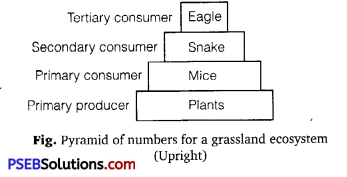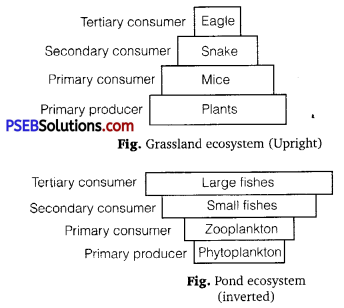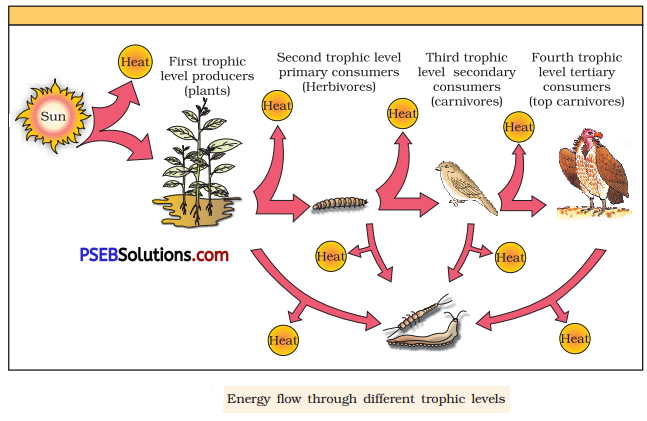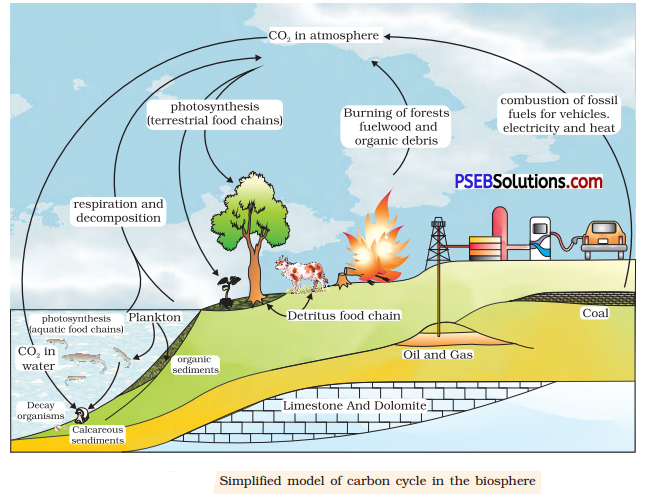Punjab State Board PSEB 12th Class Biology Book Solutions Chapter 14 Ecosystem Textbook Exercise Questions and Answers.
PSEB Solutions for Class 12 Biology Chapter 14 Ecosystem
PSEB 12th Class Biology Guide Ecosystem Textbook Questions and Answers
Question 1.
Fill in the blanks.
(a) Plants are called as ……………………………. because they fix carbon dioxide.
(b) In an ecosystem dominated by trees, the pyramid (of numbers) is ………………….. type.
(c) In aquatic ecosystems, the limiting factor for the productivity is ………………………. .
(d) Common detritivores in our ecosystem are …………………………. .
(e) The major reservoir of carbon on earth is …………………………….. .
Answer:
(a) autotrophs
(b) inverted
(c) light
(d) earthworms
(e) oceans.
Question 2.
Which one of the following has the largest population in a food chain?
(a) Producers
(b) Primary consumers
(c) Secondary consumers
(d) Decomposers
Answer:
(a) Producers (decomposers can be maximum but they are excluded from the food chain ).
Question 3.
The second trophic level in a lake is
(a) Phytoplankton
(b) Zooplankton
(c) Benthos
(d) Fishes
Answer:
(b) Zooplankton
Zooplankton are primary consumers in aquatic food chains that feed upon phytoplankton. Therefore, they are present at the second trophic level in a lake.
![]()
Question 4.
Secondary producers are
(a) Herbivores
(b) Producers
(c) Carnivores
(d) None of the above
Answer:
(d) None of the above
Plants are the only producers. Thus, they are called primary producers. There are no other producers in a food chain.
Question 5.
What is the percentage of photosynthetically active radiation (PAR) in the incident solar radiation?
(a) 100%
(b) 50 %
(c) 1-5%
Answer:
(b) 50%
Out of total incident solar radiation, about fifty percent of it forms photosynthetically active radiation or PAR.
Question 6.
Distinguish between
(a) Grazing food chain and detritus food chain
(b) Production and decomposition
(c) Upright and inverted pyramid
(d) Food chain and Food web
(e) Litter and detritus
(f) Primary and secondary productivity
Answer:
(a) Grazing food chain and detritus food chain
| Grazing food chain | Detritus food chain |
| 1. In this food chain, energy is derived from the Sun. | In this food chain, energy comes from organic matter (or detritus) generated in trophic levels of the grazing food chain. |
| 2. It begins with producers, present at the first trophic level. The plant biomass is then eaten by herbivores, which in turn are consumed by a variety of carnivores. | begins with detritus such as dead bodies of animals or fallen leaves, which are then eaten by decomposers or detrivores. These detritivores are in turn consumed by their predators. |
| 3. This food chain is usually large. | It is usually smaller as compared to the grazing food chain. |
(b) Production and decomposition
| Production | Decomposition |
| 1. It is the rare of producing organic matter (food) by producers. | It is the process of breaking down of complex organic matter or biomass from the body of dead plants and animals with the help of decomposers into organic raw material such as CO2, H2O and other nutrients. |
| 2. It depends on the photosynthetic cápacity of the producers. | It occurs with the help of decomposers. |
| 3. Sunlight is required by plants for primary production. | Sunlight is not required for decomposition by clecomposers. |
![]()
(c) upright and inverted pyramid
| Upright pyramid | Inverted pyramid |
| 1. The pyramid of energy is upright. | always The pyramid of biomass and the pyramid of, numbers can be inverted. |
| 2. In the upright pyramid, the number and biomass of organisms in the producer level of an ecosystem is the highest, which keeps on decreasing at each trophic level in a food chain. | In an inverted pyramid, the number and biomass of organisms in the producer level of an ecosystem is the lowest, which keeps on increasing at each tropic level. |
(d) Food chain and food web
| Food chain | Food web |
| 1. The transfer of energy from producers to top consumers through a series of organisms is called food chain. | A number of food chain inter-connected with each other forming a web-like pattern is called food web. |
| 2. One organism holds only one position. | One organism can hold more than one position. |
| 3. The flow of energy can be easily calculated. | The flow of energy is very difficult to calculate. |
| 4. It is always straight and proceed in a progressive straight line. | Instead of straight line, it is a series of branching lines. |
| 5. Competition is limited to members of same trophic level. | Competition is amongst members of same and different trophic levels. |
(e) Litter and detritus
| Litter | Detritus |
| l. It is made of dried fallen plant matter. | It is freshly deposited organic matter, i. e. remains of plants and animals. |
| 2. It is found above the ground. | It is found both above and below the ground. |
(f) Primary and secondary productivity
| Primary productivity | Secondary_productivity |
| 1. Primary productivity is the amount of energy accumulation or amount of biomass produced per unit area over a time period. | Secondary productivity is the rate of formation of new organic matter by consumer. |
| 2. It is of two types, gross primary productivity (GPP) and net primary productivity (NPP). They are related as: GPP – R = NPP, where R is respiratory losses. |
It is also of two types gross secondary productivity (GSP) and net secondary productivity (NSP). They are related as: NSP = GSP – R Where R is respiratory losses. |
Question 7.
Describe the components of an ecosystem.
Answer:
An ecosystem is defined as an interacting unit that includes both the biological community as well as the non-living components of an area. The living and the non-living components of an ecosystem interact amongst themselves and function as a unit, which gets evident during the processes of nutrient cycling, energy flow, decomposition, and productivity. There are many ecosystems such as ponds, forests, grasslands, etc.
The two components of an ecosystem are as follows :
(a) Biotic Component: It is the living component of an ecosystem that includes biotic factors such as producers, consumers, decomposers, etc. Producers include plants and algae. They contain chlorophyll pigment, which helps them carry out the process of photosynthesis in the presence of light.
Thus, they are also called converters or transducers. Consumers or heterotrophs are organisms that are directly (primary consumers) or indirectly (secondary and tertiary consumers) dependent on producers for their food. Decomposers include micro-organisms such as bacteria and fungi. They obtain nutrients by breaking down the remains of dead plants and animals.
(b) Abiotic Component: They are the non-living component of an ecosystem such as light, temperature, water, soil, air, inorganic nutrients, etc.
![]()
Question 8.
Define ecological pyramids and describe with examples, pyramids of number and biomass.
Answer:
An ecological pyramid is a graphical representation of various ecological parameters such as the number of individuals present at each trophic level, the amount of energy, or the biomass present at each trophic level.
Ecological pyramids represent producers at the base, while the apex represents the top-level consumers present in the ecosystem.
There are three types of pyramids:
- Pyramid of numbers
- Pyramid of energy
- Pyramid of biomass
1. Pyramid of Numbers: It is a graphical representation of the number of individuals present at each trophic level in a food chain of an ecosystem. The pyramid of numbers can be upright or inverted depending on the number of producers. For example, in a grassland ecosystem, the pyramid of numbers is upright.
In this type of a food chain, the number of producers (plants) is followed by the number of herbivores (mice), which in turn is followed by the number of secondary consumers (snakes) and tertiary carnivores (eagles). Hence, the number of individuals at the producer level will be the maximum, while the number of individuals present at top carnivores will be least.

On the other hand, in a parasitic food chain, the pyramid of numbers is inverted. In this type of a food chain, a single tree (producer) provides food to several fruit-eating birds, which in turn support several insect species.
2. Pyramid of Biomass: A pyramid of biomass is a graphical representation of the total amount of living matter present at each trophic level of an ecosystem. It can be upright or inverted. It is upright in grasslands and forest ecosystems as the amount of biomass present at the producer level is higher than at the top carnivore level.
The pyramid of biomass is inverted in a pond ecosystem as the biomass of fishes far exceeds the biomass of zooplankton (upon which they feed).

Question 9.
What is primary productivity? Give brief description of factors that affect primary productivity.
Answer:
It is defined as the amount of organic matter or biomass produced by producers per unit area over a period of time. Primary productivity of an ecosystem depends on the variety of environmental factors such as light, temperature, water, precipitation, etc. It also depends on the availability of nutrients and the availability of plants to carry out photosynthesis.
Question 10.
Define decomposition and describe the processes and products of decomposition.
Answer:
Decomposition is the process that involves the breakdown of complex organic matter or biomass from the body of dead plants and animals with the help of decomposers into inorganic raw materials such as carbon dioxide, water, and other nutrients. The various processes involved in decomposition are as follows :
1. Fragmentation: It is the first step in the process of decomposition. It involves the breakdown of detritus into smaller pieces by the action of detritivores such as earthworms.
2. Leaching: It is a process where the water-soluble nutrients go down into the soil layers and get locked as unavailable salts.
3. Catabolism: It is a process in which bacteria and fungi degrade detritus through various enzymes into smaller pieces.
4. Humification: The next step is humification which leads to the formation of a dark-colored colloidal substance called humus, which acts as reservoir of nutrients for plants.
5. Mineralisation: The humus is further degraded by the action of microbes, which finally leads to the release of inorganic nutrients into the soil. This process of releasing inorganic nutrients from the humus is known as mineralization.
Decomposition produces a dark-colored, nutrient-rich substance called humus. Humus finally degrades and releases inorganic raw materials such as C02, water, and other nutrients in the soil.
![]()
Question 11.
Give an account of energy flow in an ecosystem.
Answer:
Energy enters an ecosystem from the Sun. Solar radiations pass through the atmosphere and are absorbed by the Earth’s surface. These radiations help plants in carrying out the process of photosynthesis.
Also, they help maintain the Earth’s temperature for the survival of living organisms. Some solar radiations are reflected by the Earth’s surface.
Only 2-10% of solar energy is captured by green plants (producers) during photosynthesis to be converted into food.
The rate at which the biomass is produced by plants during photosynthesis is termed as ‘gross primary productivity.
When these green plants are consumed by herbivores, only 10% of the stored energy from producers is transferred to herbivores. The remaining 90 % of this energy is used by plants for various processes such as respiration, growth, and reproduction. Similarly, only 10% of the energy of herbivores is transferred to carnivores. This is known as ten percent law of energy flow.

Question 12.
Write important features of a sedimentary cycle in an ecosystem.
Answer:
Sedimentary cycles have their reservoirs in the Earth’s crust or rocks. Nutrient elements are found in the sediments of the Earth. Elements such as sulphur, phosphorus, potassium, and calcium have sedimentary cycles.
Sedimentary cycles are very slow. They take a long time to complete their circulation and are considered as less perfect cycles. This is because during recycling, nutrient elements may get locked in the reservoir pool, thereby taking a very long time to come out and continue circulation. Thus, it usually goes out of circulation for a long time.
Question 13.
Outline salient features of carbon cycling in an ecosystem.
Answer:
The carbon cycle is an important gaseous cycle which has its reservoir pool in the atmosphere.
All living organisms contain carbon as a major body constituent. Carbon is a fundamental element found in all living forms. All biomolecules such as carbohydrates, lipids, and proteins required for life processes are made of carbon.
Carbon is incorporated into living forms through a fundamental process called ‘photosynthesis’.
Photosynthesis uses sunlight and atmospheric carbon dioxide to produce a carbon compound called ‘glucose’.
This glucose molecule is utilised by other living organisms. Thus, atmospheric carbon is incorporated in living forms.
Now, it is necessary to recycle this absorbed carbon dioxide back into the atmosphere to complete the cycle.
There are various processes by which carbon is recycled back into the atmosphere in the form of carbon dioxide gas.
The process of respiration breaks down glucose molecules to produce carbon dioxide gas. The process of decomposition also releases carbon dioxide from dead bodies of plants and animals into the atmosphere. Combustion of fuels, industrialization, deforestation, volcanic eruptions and forest fires act as other major sources of carbon dioxide.
